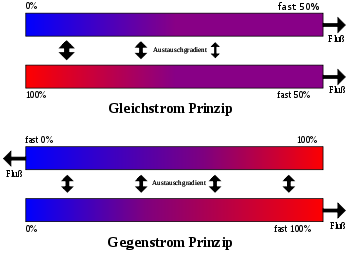Counterflow principle (process engineering)
The countercurrent principle (also the countercurrent process ) is a method used for heat or material exchange, in which two material flows are led past each other in opposite directions. It is a fundamental principle of process engineering , but it can also be found in nature, for example in the oxygen intake of some animals through the lungs or gills , the concentration of urine in the kidneys , or in the blood flow to waterfowl feet and the muscles of some bony fish , sharks and rays (for "warm blood").
With the countercurrent principle, two material flows - for example cold and warm air (in the heat exchanger ) or flue gas and scrubbing liquid (in a column ) - flow past each other from opposite directions and bring them into contact with each other in such a way that the exchange of material or heat is possible between them . Since there is always a temperature or concentration gradient between the material flows due to the current flow, it is (ideally) possible to transfer almost the entire heat or material load from one material flow to the other. This is particularly important in separation technology and in heat recovery . The process was formulated by Werner von Siemens in 1857 and used on an industrial scale for the first time by Carl von Linde in 1895.
In the figure on the right, a heat exchanger is shown in the lower half of the image, which works according to the countercurrent principle. The lower air flow is the fresh air supply of a residential building, which is to be preheated with the exhaust air from the same house. You can see that the fresh air gradually takes over almost all of the heat energy of the exhaust air as it passes through the heat exchanger from left to right. In the end, only a small part of the heat is lost; this cannot be prevented because a finite driving temperature gradient is always necessary for heat transfer - otherwise the heat exchanger would have to be infinitely long. If the current was conducted according to the direct current principle , at most half of the heat could be recovered.
Mass transfer processes such as thermal separation processes or membrane separation processes work on the same principle.
See also
Individual evidence
- ↑ Klaus Beneke: Karol Stanislaw Olszewski and the history of the liquefaction of gases (PDF; 744 kB)
